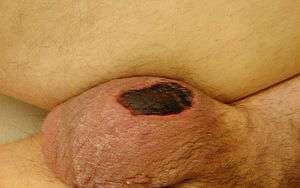Fournier gangrene
| Fournier gangrene | |
|---|---|
 | |
| Classification and external resources | |
| Specialty | Infectious disease |
| ICD-10 | N49.8 (ILDS N49.81), N76.8 |
| ICD-9-CM | 608.83 |
| DiseasesDB | 31119 |
| eMedicine | emerg/929 med/2814 |
| MeSH | D018934 |
Fournier gangrene is a type of necrotizing fasciitis or gangrene affecting the perineum. It commonly occurs in elderly men, but it can also occur in women and children. It is more likely to occur in those with diabetes, alcoholics, or those who are immune compromised.
It was first described by Baurienne in 1764 and is named after a French venereologist, Jean Alfred Fournier following five cases he presented in clinical lectures in 1883.
Cause
In the majority of cases Fournier gangrene is a mixed infection caused by both aerobic and anaerobic bacteria.[1] Death can result from Fournier gangrene.[2]
Treatment
Fournier gangrene is a urological emergency requiring intravenous antibiotics and debridement (surgical removal) of necrotic (dead) tissue. In addition to surgery and antibiotics, hyperbaric oxygen therapy (HBOT) may be useful and acts to inhibit the growth of and kill the anaerobic bacteria.[3] Despite such measures, the mortality rate overall is 40%, but 78% if sepsis is already present at the time of initial hospital admission.[4]
Epidemiology
An estimated 750 cases have been reported in the literature,[5] with most people in their 60s or 70s with other illnesses.[6] According to another study in 2000, there have been at least 1726 reported cases in the English literature.[7] However, Fournier gangrene is not a reportable illness, so the number of unreported cases is unclear. A similar infection in women has been occasionally described.[8]
In Turkey it was reported that 46% of patients had diabetes mellitus[4] while other studies have identified approximately a third of patients having either diabetes, alcoholism or malnutrition, and 10% having medical immunosuppression (chemotherapy, steroids, or malignancy).[9]
Notable cases
The most historically prominent sufferers from this condition may have been Herod the Great, his grandson Herod Agrippa, and possibly the Roman emperor Galerius. Puerto Rican abolitionist and pro-independence leader Segundo Ruiz Belvis died from Fournier gangrene in November 1867.
See also
References
- ↑ Thwaini A, Khan A, Malik A, Cherian J, Barua J, Shergill I, Mammen K (2006). "Fournier's gangrene and its emergency management". Postgrad Med J. 82 (970): 516–9. doi:10.1136/pgmj.2005.042069. PMC 2585703
 . PMID 16891442.
. PMID 16891442. - ↑ "Non-Traumatic Urologic Emergencies in Men: A Clinical Review". PubMed Central (PMC).
- ↑ Zamboni WA, Riseman JA, Kucan JO (1990). "Management of Fournier's Gangrene and the role of Hyperbaric Oxygen". J. Hyperbaric Med. 5 (3): 177–186. Retrieved 2008-05-16.
- 1 2 Yanar H, Taviloglu K, Ertekin C, Guloglu R, Zorba U, Cabioglu N, Baspinar I (2006). "Fournier's gangrene: risk factors and strategies for management". World J Surg. 30 (9): 1750–4. doi:10.1007/s00268-005-0777-3. PMID 16927060.
- ↑ Burch DM, Barreiro TJ, Vanek VW (November 2007). "Fournier's gangrene: be alert for this medical emergency" (PDF). JAAPA. 20 (11): 44–7. doi:10.1097/01720610-200711000-00020. PMID 18035764.
- ↑ Vaz I (2006). "Fournier gangrene". Trop Doct. 36 (4): 203–4. doi:10.1258/004947506778604724. PMID 17034687.
- ↑ Eke N. (2000). "Fournier's gangrene: a review of 1726 cases". British Journal of Surgery. 87 (6): 718–728. doi:10.1046/j.1365-2168.2000.01497.x.
- ↑ Herzog W (1987). "[Fournier gangrene--also in females?]". Zentralbl Chir. 112 (9): 564–76. PMID 2956804.
- ↑ Tahmaz L, Erdemir F, Kibar Y, Cosar A, Yalcýn O (2006). "Fournier's gangrene: report of thirty-three cases and a review of the literature". Int J Urol. 13 (7): 960–7. doi:10.1111/j.1442-2042.2006.01448.x. PMID 16882063.